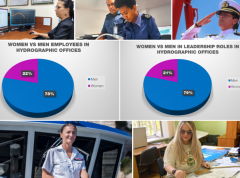Importance of Hydrography
Definition of Hydrography
Hydrography is the branch of applied sciences which deals with the measurement and description of the physical features of oceans, seas, coastal areas, lakes and rivers, as well as with the prediction of their change over time, for the primary purpose of safety of navigation and in support of all other marine activities, including economic development, security and defence, scientific research, and environmental protection.
In addition to supporting safe and efficient navigation of ships, hydrography underpins almost every other activity associated with the sea, including:
- resource exploitation - fishing, minerals,..
- environmental protection and management
- maritime boundary delimitation
- national marine spatial data infrastructures
- recreational boating
- maritime defence and security
- tsunami flood and inundation modelling
- coastal zone management
- tourism
- marine science
International Obligations
In July 2002, the revised Chapter V of the IMO Safety of Life at Sea (SOLAS) Convention entered into force. Under the new Regulation 9, the Contracting Governments of SOLAS are now required to provide and maintain Hydrographic Services and products.
In the past few decades, the following important factors have emphasized the need for adequate hydrographic survey coverage and the production of nautical charts and publications as required by SOLAS Chapter V;
- the advent of exceptionally deep draught VLCC ships
- the need to protect the marine environment
- changing maritime trade patterns
- the growing importance of seabed resources
- and the U.N. Law of the Sea Convention affecting areas of national jurisdiction
Many charts which were adequate a decade ago, may have to be recompiled using new survey data, collected to a higher degree of accuracy and providing improved coverage. This deficiency may not be limited to sparsely surveyed waters of developing nations, but may also apply to the coastal waters of major industrial states. The advent of accurate satellite navigation, has made poorly positioned historical data an even greater problem for navigators. Fortunately, new survey technologies have improved the precision to which modern hydrographic surveys can be conducted.
United Nations view on the importance of Hydrography
On 23 December 2003, the United Nations General Assembly adopted Resolution A/RES/58/240 on Oceans and Law of the Sea that dealt, in large part, with safety of navigation. In this resolution, the General Assembly:
(a) Welcomes the work of the International Hydrographic Organization (IHO) and its 14 Regional Hydrographic Commissions and encourages increased membership of the IHO by States, noting that organization's capacity to provide technical assistance, facilitate training and identify potential funding sources for development or improvement of hydrographic services; and calls upon States and agencies to support the IHO trust fund and examine the possibility of partnerships with the private sector;
(b) Invites IHO and the International Maritime Organization (IMO) to continue efforts and to jointly adopt measures with a view to encouraging greater international cooperation and coordination for the transition to electronic nautical charts; and to increase the coverage of hydrographic information on a global basis, especially in areas of international navigation and ports and where there are vulnerable or protected marine areas;
(c) Encourages intensified efforts to build capacity for developing countries, in particular for the least developed countries, small island developing States and coastal African States, to improve hydrographic services and the production of nautical charts, including the mobilization of resources and building of capacity with support from international financial institutions and the donor community, recognizing that economics of scale can apply in some instances at the regional level through shared facilities, technical capabilities and information for the provision of hydrographic services and the preparation of and access to nautical charts.




Share this page: